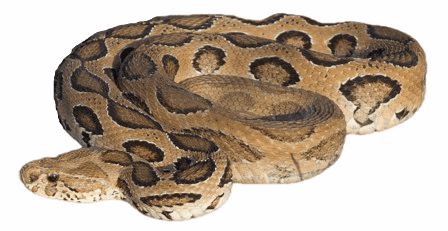The Russell’s viper snake is a venomous snake in the family of Viperidae. The scientific name of Russell’s viper snake is Daboia russelii. The native place of Russell’s viper is Indian sub continent, Nepal, Sri Lanka, Pakistan and Bangladesh. It is the one of the biggest snake in India. It was described by the George Shaw and Frederick Polydore Nodder in 1797. Patrick Russell collected Indian snakes on the Coromandel Coast in his 1796 work and it was named after Patrick Russell.

Russell’s viper snake is commonly found in fields, grasslands, etc.
In India, Russell’s viper is found mostly in the state of Punjab. Russell’s viper snakes are commonly found along the western coast and hills of southern India, especially in the state of Bengal and north to Karnataka. It is rarely seen in Assam and North Bengal states.
Russell’s viper snake has no specific habitat, but it avoids dense forests. The snake is mostly found in open, bushy or grassy areas and can also be found in growth forests or agricultural lands. It is commonly seen in coastal lowlands, hills and plains of suitable habitats. The head of the Russell Viper is flat, triangular and also distinct from the neck.
Russell’s viper snake face is blunt, round and upturned.
The nostrils are large, and there is a single nasal scale in the center of each large one. The lower edge of the nasal level touches their naso rostral level. The supranasal scale has a strong crescent shape and separates anteriorly from the nasorostral scale, not the nasal.
Russell’s viper snake venom is highly toxic. The venom of adult species is 130 mg to 250 mg, 150 mg to 250 mg and 21 to 268 mg. It releases 40 mg to 70 mg of venom in a single bite to humans. Post-bite symptoms begin with pain at the bite site. Immediately the area becomes swollen and bleeding is a common symptom. Blood pressure and heart rate drops in the next stage. Vomiting and facial swelling occur in about one-third of all cases.
The rostral scale is very broad and high. The crown of the head is covered with irregular and strongly broken scales. Supraocular scales are single, narrow and separated by 6 to 9 scales around the head. The eyes are large and yellow or golden in color. It is surrounded by 10 to 15 circumorbital scales.
Russell’s viper snakes have 10 to 12 supralabials and the 4th and 5th are the largest.
The eye of Russell’s viper is separated from the supralabials by 3 or 4 rows of sub oculars. The front pair is noticeably enlarged of the two pairs of chin shields. The Russel viper snake will become very aggressive when anyone disturbed. They will threaten by forming S shape and raise head first. Then it will raise the first third of the body and will make a hiss sound louder than any other snake. It remains motionless in the same position as before biting and exerts a lot of force while biting. A Russell’s viper attacks by raising most of its body off the ground when biting.
Russell’s viper snake has two maxillary bones can support at least two and the mostly five or six pairs of fangs at a time.
The fangs will attain a length of 16.5 mm as in the average specimen. It has a stout body. The cross section of which is rounded to circular. The dorsal scale on the mid body is 27 to 33 and the ventral scales number is 153 to 180.
If not treated properly after Russel’s viper snake bite, then the person is more likely to die. If treated and survives, severe pain near the bite may last for 2 to 4 weeks. In some cases, kidney, heart failure, or respiratory system damage can occur 1 to 14 days after a Russell’s viper bite, even if treated.
Russell’s viper anal plate is not divided. The tail is very short and is about 14% of the total length.
The paired sub caudal is numbered up-to 41 to 68. The Russell vipers dorsal color pattern will consists of a deep yellow, brown color and tan. This 3 series of dark spots will have a black ring around it.
Russell’s viper outer border of which is sharpening with a rim is in white or in yellow colors. The dorsal spots number is 23 to 30 that may grow together while the side spots will break apart. The head will have a distinct pair of dark patches. The belly is in white, yellowish, and whitish or in pinkish with an irregular scattering of the dark spots.
The Russell’s viper snake length is 166 cm (65 inches) and it averages about 120 cm (47 inches) in the mainland Asia. It will be shorter or average in the Islands. It is slimmer compared to the other vipers. The length of the tail is 430 mm (17 inches). The width of the head is 51 mm (2 inches) and the length of the head is 51 mm (2 inches).
